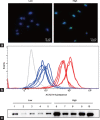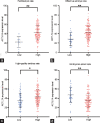Sperm-specific protein ACTL7A as a biomarker for fertilization outcomes of assisted reproductive technology
- PMID: 35532568
- PMCID: PMC9226699
- DOI: 10.4103/aja2021111
Sperm-specific protein ACTL7A as a biomarker for fertilization outcomes of assisted reproductive technology
Abstract
Obtaining high-quality embryos is one of the key factors to improve the clinical pregnancy rate of assisted reproductive technologies (ART). So far, the clinical evaluation of embryo quality depends on embryo morphology. However, the clinical pregnancy rate is still low. Therefore, new indicators are needed to further improve the evaluation of embryo quality. Several studies have shown that the decrease of sperm-specific protein actin-like 7A (ACTL7A) leaded to low fertilization rate, poor embryo development, and even infertility. The aim of this study was to study whether the different expression levels of ACTL7A on sperm can be used as a biomarker for predicting embryo quality. In this study, excluding the factors of severe female infertility, a total of 281 sperm samples were collected to compare the ACTL7A expression levels of sperms with high and low effective embryo rates and analyze the correlation between protein levels and in-vitro fertilization (IVF) laboratory outcomes. Our results indicated that the ACTL7A levels were significantly reduced in sperm samples presenting poor embryo quality. Furthermore, the protein levels showed a significant correlation with fertilization outcomes of ART. ACTL7A has the potential to be a biomarker for predicting success rate of fertilization and effective embryo and the possibility of embryo arrest. In conclusion, sperm-specific protein ACTL7A has a strong correlation with IVF laboratory outcomes and plays important roles in fertilization and embryo development.
Keywords: actin-like 7A; assisted reproductive technology; biomarker; embryo quality; fertilization outcomes; in-vitro.
Conflict of interest statement
None
Figures





References
-
- Enien WM, El Sahwy S, Harris CP, Seif MW, Elstein M. Human chorionic gonadotrophin and steroid concentrations in follicular fluid: the relationship to oocyte maturity and fertilization rates in stimulated and natural in-vitro fertilization cycles. Hum Reprod. 1995;10:2840–4. - PubMed
-
- Zaninovic N, Irani M, Meseguer M. Assessment of embryo morphology and developmental dynamics by time-lapse microscopy: is there a relation to implantation and ploidy? Fertil Steril. 2017;108:722–9. - PubMed
-
- Balakier H, Cadesky K. The frequency and developmental capability of human embryos containing multinucleated blastomeres. Hum Reprod. 1997;12:800–4. - PubMed
-
- Jackson KV, Ginsburg ES, Hornstein MD, Rein MS, Clarke RN. Multinucleation in normally fertilized embryos is associated with an accelerated ovulation induction response and lower implantation and pregnancy rates in in vitro fertilization-embryo transfer cycles. Fertil Steril. 1998;70:60–6. - PubMed
MeSH terms
Substances
LinkOut - more resources
Full Text Sources
Medical

